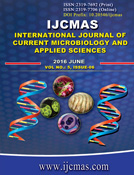


 National Academy of Agricultural Sciences (NAAS)
National Academy of Agricultural Sciences (NAAS)

|
PRINT ISSN : 2319-7692
Online ISSN : 2319-7706 Issues : 12 per year Publisher : Excellent Publishers Email : editorijcmas@gmail.com / submit@ijcmas.com Editor-in-chief: Dr.M.Prakash Index Copernicus ICV 2018: 95.39 NAAS RATING 2020: 5.38 |
Septicemia remains a significant cause of morbidity and mortality in the new-borns. The main objective of the study was to identify the common bacterial pathogens associated with neonatal sepsis and their antibiotic sensitivity pattern. During July 2015 and August 2015, 232 Blood samples were collected aseptically from newborns with sepsis in Govt. Kilpauk Medical College, Chennai and processed by standard conventional method. Antibiotic susceptibility pattern of isolates was studied by Kirby Bauer Disc diffusion technique as per the CLSI recommendations. 83 out of 232 cases were culture positive, giving a culture positivity rate of around 35.77%. Males were more affected than their female counterparts. 85.5% of cases are reported in the early days of life and Gram negative bacilli were found to be the commonest cause of neonatal septicemia (56.5%). Klebsiella pneumonia (39.75%) was the most frequent isolate which showed 90.9% sensitivity against Amikacin. All the Gram negative bacilli were found to be highly sensitive to third generation cephalosporins especially Cefperazone sulbactum . All the gram positive isolates showed 100% sensitivity to Vancomycin. The study concludes that it is important to continue the tracking of neonatal septicemia in order to closely monitor the changes in trends, to obtain information for empiric antibiotic therapy and to act rapidly in case of emergencies. Since Govt. Kilpauk Medical College being a tertiary health care centre, most of its sepsis cases are referred ones. Hence awareness should be created about institutional deliveries along with antenatal and postnatal care.
 |
 |
 |
 |
 |